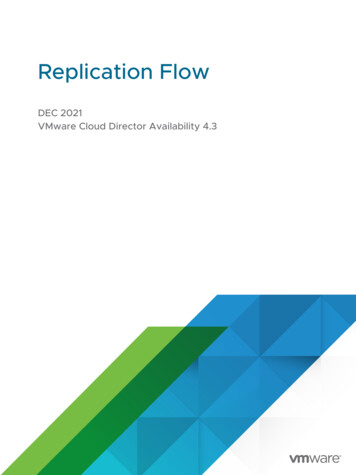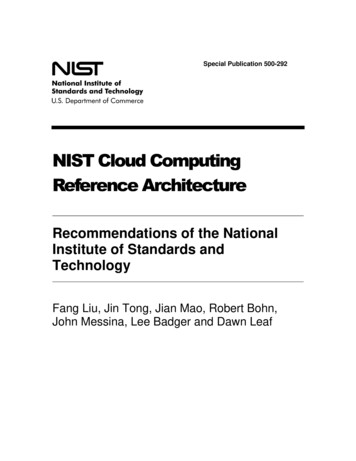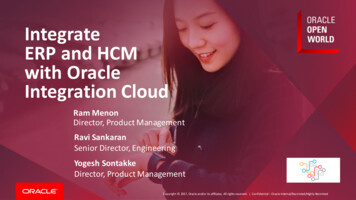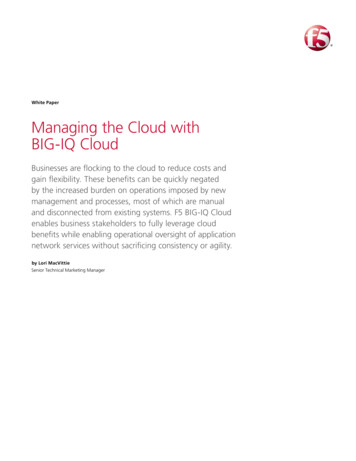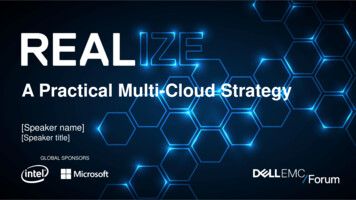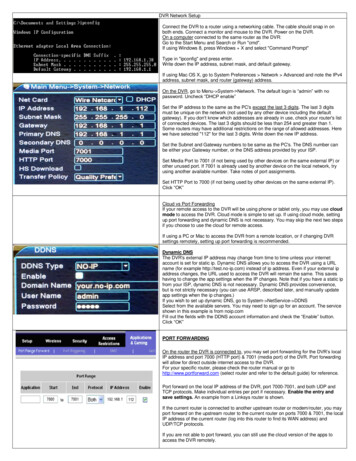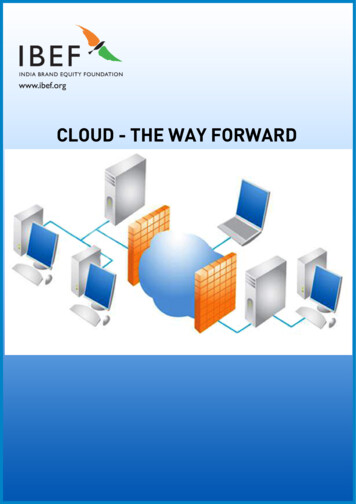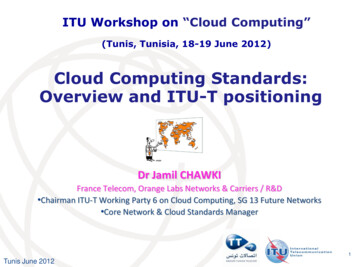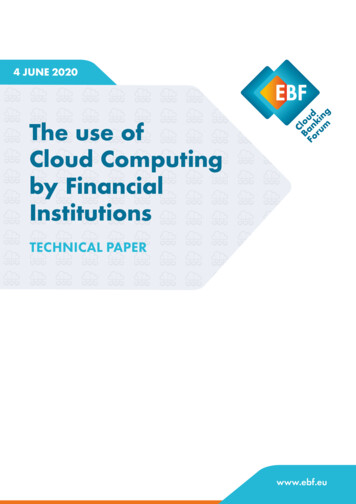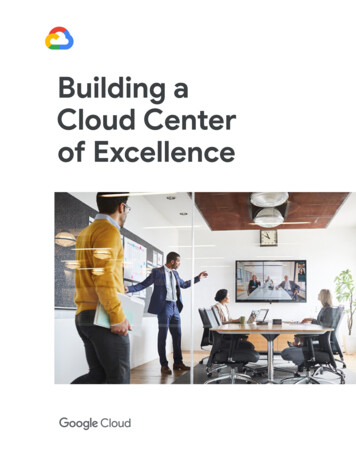
Transcription
Building aCloud Centerof Excellence
ContentsEnsuring success in the cloud .1The Cloud Center of ExcellenceThe Google Cloud Adoption FrameworkA deeper dive into the Cloud Center of Excellence . 4The characteristics and focus of a Cloud COEThe evolution of the Cloud COEThe Cloud COE and measurementThe most significant measure of successBuilding a Cloud Center of Excellence . 11Strong executive sponsorshipOrganizational analysisTeam member activitiesTeam member rolesTeam member skillsTeam member trainingStaffing the Cloud COEEngaging with the organizationChecklist: What's your readiness for aCloud Center of Excellence? . 24
1Ensuring success in the cloudThe rush to the cloud is accelerating, as the benefits of a move to thecloud increase. To make that transition smooth and successful,however, your organization will need to do some careful preparation.You’ll want to align your cloud strategy with your larger organizationalstrategy and to consider also how your business will transform as aresult of this technological change.And you’ll need solid and widespread advocacy from within theorganization. Without such advocacy, all responsibility for generatingenthusiasm and momentum for cloud adoption rests with theexecutive sponsors. This top-down approach can be slow to scale,but also fails to embrace the inherent democratization of IT resourcesthat cloud computing offers.One way of generating such advocacy is to bring together a group ofpeople from within the organization to provide leadership, bestpractices, research, support, and training for the move to the cloud.With a team like this, it becomes easier to foster engagement andmomentum organically, and also to create the infrastructure and theframeworks necessary to become a cloud-first business. As thestrongest advocates for cloud adoption within the organization, theteam helps to ignite enthusiasm. They can also serve as a catalyst forinnovation. They will find new ways to achieve the desired goals— and deeply attuned to the business strategy as they are, theinitiatives and pilot projects that this group develops are more likely toevolve into endeavors that position the organization for long-termsuccess.Foster engagementand momentumorganically, andcreate theinfrastructure andframeworks tobecome a cloud-firstbusiness
2The Cloud Center of ExcellenceBuilding an internal team to drive success is a natural inclination. At Google, we’ve seen this team calledmany different things. Cloud Services, Innovation Council, Cloud Engineering, even Cloud Platform. Werefer to a team so organized and directed as a Cloud Center of Excellence, or a Cloud COE.A well-appointed Cloud COE begins with a small team who understands the Google Cloud AdoptionFramework and is able to use it as a guide for implementing cloud technology aligned with a business’sgoals and strategy. The Cloud COE team then becomes the conduit for transforming the way that theother internal teams serve the business in the transition to the cloud.The Cloud COE team accelerates cloud adoption by: Driving momentum across the organization Developing reusable frameworks for cloud governance Managing cloud knowledge and learning Overseeing cloud usage and plans for scale Aligning cloud offerings to the larger organizational strategyA Cloud COE is not a static entity. Rather, it continually evolves to keep pace with the innovationassociated with adopting the cloud. Executive leadership should design the Cloud COE as an adaptivestructure that evolves as the needs of the organization do.
3The Google Cloud Adoption FrameworkA successful Cloud COE is guided by the Google Cloud Adoption Framework, which builds a structureon the rubric of people, process, and technology that produces actionable programs within the themesof Learn, Lead, Scale, and Secure. This framework is informed by Google’s own evolution in the cloudand many years of experience helping customers.The Cloud COE is the team that drives the cloud maturity of the organization forward and sets theagenda of the activities articulated in the Google Cloud Adoption Framework
4A deeper dive into the Cloud Center of ExcellenceRunning a Cloud COE is a full-time job in a large organization. Its team members are aligned with thebusiness strategy. They collaborate with the rest of the organization in achieving their goals. And theyare fully committed to the success of this move to the cloud.The team that makes up the Cloud COE must also be cross-functional. As they will have the authority tomake decisions regarding architecture and process, they will need expertise in all things cloud.The characteristics and focus of a Cloud COECentral to the Cloud COE’s role is setting the foundation for a successful cloud migration andencouraging a culture of collaboration and knowledge sharing. Cloud COE team members advise onand implement solutions, providing both thought leadership and hands-on support. In practical terms, aCloud COE can be established based on practices, workstreams, processes, tools, or other significantstructuring factors.As it is the needs, the priorities, and the capabilities of the business that drive the structure and scopeof the Cloud COE, each Cloud COE will look a little different. And the current state of cloud maturity ofthe team will drive its orientation and activities.Across organizations, however, there are several characteristics that successful Cloud COEs will have incommon:
5The most successful Cloud COE teams are: Multidisciplinary: Members of the team reflect the diverse perspectives of the stakeholders in theproject. Empowered: The Cloud COE should have decision-making power without need for higher-levelsign-off. Visionary: The Cloud COE should consider a multi-project viewpoint to understand repeatabilityand long-term benefits or goals for the organization. Agile: The Cloud COE should understand the necessary requirements to be able to deliver shortterm wins such as short development cycles and an iterative approach to building products. Technical: The Cloud COE should include experienced individuals with a history of architecting andbuilding past solutions within the organization. Engaged: The individuals within the Cloud COE should be dedicated, able to commit full-time to theendeavor and the process. Cloud-centric: The Cloud COE should include members who will specialize in the cloud and cloudspecific functions. Integrated: The individuals within the Cloud COE should be sourced from existing areas of thebusiness to allow for easy integration into existing teams and organizational constructs. Hands-on: Within a Cloud COE, there should be individuals who are able to do the hands-on workneeded to build and test cloud solutions. Small: The Cloud COE should start as small as possible, ideally 10 team members or fewer, whilestill incorporating the knowledge and expertise to accomplish the other characteristics.
6Both the cloud maturity level of the organization and its business strategy determine the focus of theCloud COE. Some Cloud COEs focus on best practices; others focus on standardization, improvements,or innovation. In terms of cloud maturity level, a focus on driving transformational cloud maturity for anorganization would mean: Inspiring engineers to work on cloud technologies, including training and enablement Leveraging agile techniques and a fail-fast approach to research services that fit the modelappropriate to the organization and existing data center platforms Collecting the data that will determine the patterns of future successWhich focus to adopt depends on the most pressing needs and goals of the organization. Those needsand goals are defined by the executive team, and the Cloud COE streamlines its services based onthem.The Cloud COE is designed to meet the needs of individual organizations. No two Cloud Centers ofExcellence will look quite the same.
7The evolution of the Cloud COEIndividual Cloud COEs differ across organizations, and they also differ across time. The organizationalknowledge and capabilities that the Cloud COE reflects will evolve over time, as will the cloud maturitylevel of the organization. The Cloud COE must evolve with it.As the Cloud COE evolves, it will increasingly be populated with engineers who have experience and adeep understanding of how critical functions currently operate. They will know how to translate existingdata center–based platforms into cloud-based platforms, and how to host greenfield applications onthe cloud platform using cloud-native services.A high-level view of the evolution and alignment of a Cloud COE captures the activities and outcomes interms of timeframe:
8The Cloud COE and measurementA successful cloud migration is determined by how well anorganization adopts the cloud relative to their desired goals.The Cloud Adoption Framework anchors the concept of cloudmaturity in four themes (Learn, Lead, Scale, Secure) and thecorresponding workstreams (or epics) required to determinesuccessful cloud adoption. To define their goals for cloud adoption,the executive team should agree both on the current cloud maturitylevel for the organization and on which level they’d like to take it to.With cloud maturity goals defined, success metrics can then bedeveloped. These metrics should align both to the larger businessstrategy and to the cloud maturity goals, defining desired outcomes interms of tangible, measurable results.The role of the Cloud COE is to drive progress towards these tangibleand measurable results. Tracking key performance indicators (KPIs)allows the executive team and Cloud COE members to aligncommunications, training, and practices to help employees internalizethe change and incorporate the cloud into their work.Measuring and analyzing the right KPIs is critical for understandingthe value delivered by the cloud both to individuals and to theorganization. This, in turn, allows for more rapid cloud maturity, asmeasurable success drives user buy-in and senior sponsorship, aswell as identifying key areas for focus and improvement.Your metrics forsuccess should alignboth to your largerbusiness strategyand to your cloudmaturity goals
9The most significant measure of successA Cloud COE is successful to the extent that it successfully drives cloud adoption.If employees feel that the Cloud COE is collaborative and that it helps facilitate cloud deploymentand usage, they will be more likely to use its services to work together in building better technology,processes, and culture. If they feel coerced or that the Cloud COE has its own separate agenda, theyare less likely to embrace the COE or work with it.The Cloud COE must strive always to inspire, to guide, and to support. It is an enabler of successand exists to help the overall organization achieve its goals. The Cloud COE is only successful if thevarious teams and organizations it supports are successful on their cloud journeys.
10Building a Cloud Center of ExcellenceThe best timing for building your Cloud COE is well before undertaking the first cloud migration.However, there is never a bad time to introduce best practices and cloud governance. Setting up aCloud COE midway through your cloud journey still offers many opportunities to realize benefits andbetter alignment with your strategic goals for cloud adoption.Once the Cloud COE members are selected and the Cloud COE is evangelized across the organization,it is important to quickly create momentum and begin the work to set the foundation for the cloud.Strong executive sponsorshipA successful Cloud COE empowers transformation. For a Cloud COE to be successful, it must itself beempowered, endorsed, and supported by strong executive sponsors. Comprehensive buy-in shouldexpand across the C-suite and must reach across business functions, not just the Information andTechnology (IT) function. Strong executive sponsors are actively involved in cloud deployments. Theychampion Cloud COE practices across the organization. And they support the Cloud COE through itsevolution.Strong executive sponsors in the form of an executive committee will: Co-develop objectives with the Cloud COE to make sure that activities align with the businessstrategy, and communicate this to the wider business and projects team(s) Create a communication channel for the Cloud COE for the purpose of quickly raising issues andrisks with the committee Announce and promote the Cloud COE communication channel(s) within the business Agree on the engagement model for the committee with the Cloud COE and between Cloud COEand businesses/functions Secure funding for the resources to staff the Cloud COE and for all the initiatives led by the COE
11Organizational analysisAny cloud implementation strategy should be grounded in anorganizational analysis. Included in the analysis are documenting theorganization’s cloud vision and establishing measurable goals. Thecloud vision maps business objectives and needs to technologycapabilities. It provides the sponsor with a key tool for selling thebenefits of moving to the cloud to stakeholders and decision makerswithin the enterprise. The vision is critical to establishing a realisticadoption strategy. It provides the business context for making cloudcomputing transformational for your business.You might kick off an organizational analysis with a workshop todiscuss the cloud adoption journey and to make the key decisionsrequired. Include stakeholders with both technical and businesspoints of view. You will need both perspectives in the discussion. Thecore question to be answered is, “What will adopting the cloud do forus as a company? What outcome are we looking for?” To get at thatcentral issue, the conversation may explore questions such as these: Why are we investing in the cloud? How is technology used in our enterprise? How can the cloud address business challenges through threedistinct lenses: technology, economics, and security? Will we be striving for innovation? To be the best in our industry?As part of the discussion, you will need to evaluate the maturity ofyour organization’s cloud capabilities. Determining that maturity level,in turn, enables you to define measurable goals for successful cloudadoption.Determining yourmaturity levelenables you todefine measurablegoals for successfulcloud adoption
12The Google Cloud Adoption Framework provides a Cloud Maturity Assessment to assist you with boththese tasks. Completing a Cloud Maturity Assessment then enables you to turn to questions such asthese: What is the critical path for achieving a successful cloud adoption? How can the organization’s culture be aligned with the technological changes? What policies and procedures will be impacted as part of the cloud adoption journey? What potential challenges can impact the training and communication required to drive cloudadoption within the organization?With capabilities and goals defined, you can then consider how best to shape your Cloud COE, withquestions such as these: Which projects can become a part of the Cloud COE as either a pilot or a proof of concept? Who would be the stakeholders and/or owners for the identified workstreams? Who can become a part of the early cloud adoption program, while driving an effective feedbackchannel to the Cloud COE?Team member activitiesThe Cloud COE is a cross-functional team of people with deep skills and expertise. At a high level, theteam undertakes to shape and support the direction of the company across five domains:
13A range of activities underpins those efforts:Cloud COE activitiesActivitiesTasksAccelerate cloud adoption Increase cloud product/feature use Unlock cloud capabilities Implement a well-designed cloud architecture Advocate for cloud adoption by sharing success stories Develop reusable tools and artifactsAdoptionEncourage collaboration Create and promote communication channels Minimize collaboration barriers across functions Define and monitor cross-functional collaboration activitiesIncrease awareness Give employees access to information Delegate authority and empower employees to take decisions Encourage open communication throughout the organizationCloud advisory Advise on cloud methodology Advise on release managementGovernanceCloud optimization Oversee cloud utilization and address under- and overutilization Improve data usage and management Standardize processes and methodologies Incorporate agile methodology in cloud releasesDefine cloud roadmap(s) Define future cloud products and features Align future cloud usage to the business roadmap Prepare for scale and optimization
14GovernanceGovernance Tailor cloud architecture to business needs Develop management governance for the design, build, and release phases Build cloud architecture frameworks Design cloud processes Develop development guidelinesRetooling Standardize tools across functions Create tools to be used in cloud initiativesBest practices Work with different functions to capture best practices Disseminate best practices across teams Continuously capture and propagate best practices Adjust processes based on best practicesInternal expertise Create technical excellence within the organization Advise on the recruiting, training, and upskilling of cloud employeesKnowledgeKnowledge management Serve as a centralized point of knowledge management Capture and encourage best practices Become the centralized point for questions about the cloud Support the development of the training approachLearning culture Encourage continuous learning Develop a culture of excellence and knowledgeThought leadership Develop practices that are specific to the organization Develop points of view on the cloud and the organization Manage asset creation and publication
15Cloud management Monitor cloud usage Manage cloud permissionsCost optimization Monitor costs Manage billingOperationsMetrics and KPIs Identify metrics Capture and update metrics Report metrics to executive team and organizationOnboarding Onboard new members to the Cloud COESecurity Incorporate security protocols into the cloud architecture Manage access and identity Manage cloud permissionsGrowth Prioritize projects and initiatives Deploy the cloud strategy Modernize infrastructure technology Accelerate go-to-market productsInnovation Use the cloud to develop new use cases Spearhead technological innovationsStrategyIntegration Align the cloud strategy to the larger organizational strategy Promote cross-functional integrationProgram management Plan sprints, releases, and upgrades Monitor access and identityStrategic alignment Ensure business alignment Communicate with the executive team often to adapt a cloud strategy forpotential organizational strategy changes
16Team member rolesThe roles in a Cloud COE will vary based on the organization’s maturity in the cloud and its specificneeds. Small organizations might have a number of people sharing particular roles (for example,security and networking), but large organizations are likely to separate roles out by individuals. Theintent is to create a team with the ability to move at the pace necessary to achieve the organization’sstrategic goals.The following roles are typical of well-staffed Cloud COEs:Cloud COE rolesCloud COELeadOversees the Cloud COE. Responsible for working with the executive team on cross-teamcollaboration, next steps, sponsorship, and overall management of the Cloud COE.DeveloperOperations andInfrastructureLeadResponsible for the team’s project management and execution. In addition, alignsdevelopers to best practices and essential standards. Consults on edge cases and uniqueneeds. Builds the applications and tools needed for app deployment and management.Specializes in working on cloud computing systems. Develops the next-generationproducts and applications on cloud technologies. Helps determine how the system shouldoperate and provides guidance to the programmers who help write the application code,aligning developers to best practices and essential standards. May design new systems orupgrade existing systems.SoftwareEngineer/Cloud ArchitectConsults with the business team on how to design cloud applications for optimal scaling.Represents the enterprise’s APIs to Cloud COE consumers and partners throughevangelism, onboarding, documentation, and support.Additionally, has a creative and technical mindset that empowers the organization to usethe cloud, likely using a “Train the Trainer” approach to train counterparts and achievescale. Keeps up to speed and promotes the latest trainings and certifications, and designsand maintains customized programs
17Site ReliabilityEngineerEnsures that services — both internally critical and externally visible systems — havereliability and uptime appropriate to users’ needs and a fast rate of improvement, whilekeeping an eye on capacity and performance. Responsible for availability, latency,performance, efficiency, change management, monitoring, emergency response, andcapacity planning. Focuses on the health of the Google Cloud Platform (GCP)infrastructure.Site Reliability Engineering (SRE) is a discipline that combines software and systemsengineering to build and run large-scale, massively distributed, fault-tolerant systems.SRE is also a mindset and a set of engineering approaches to running better productionsystems.Responsible for the team’s project management and execution. Oversees the cloudCloudarchitecture, network engineering, security, and software engineers, cloud engineers, andEngineering Leaddevelopers in the team.Network EngineerResponsible for external-facing network infrastructure (public-facing IPs, firewalls, cloudDNS, cloud interconnect, NAT/egress control), including connectivity to provide privatenetworking to other infrastructure. Helps to develop and ensure that the design andfeature enhancements keep systems running smoothly.Also ensures that network operations are safe and efficient by monitoring networkperformance, coordinating planned maintenance, adjusting hardware components, andresponding to network connectivity issues. The network engineering team is responsiblefor operating the cloud network reliably and at scale.Responsible for the security of applications and infrastructure in the cloud. Helps toensure that software and services are designed and implemented to the highest securitySecurity Engineer standards. Performs security audits, risk analysis, application-level vulnerability testing,and security code reviews for a wide variety of products. Works closely with othersoftware engineers to enhance the overall security posture.Cloud DeveloperOperations andInfrastructureEngineerGuides the process of configuring and deploying the cloud infrastructure, consisting ofidentity and access management, network architecture, application security, logging,monitoring, billing, and more. Consults with various teams across the organization on howto design their cloud applications for optimal scaling, including CDN design, load balancersetup, caching, compute optimizations, continuous integration and delivery pipeline, andmore.Additionally, works closely with Product Management and Product Engineering to buildand drive excellence across products.
18TechnicalSolutionsEngineerWorks closely with engineering, site reliability, and deployment teams to improve thecritical tools and support process that enable cloud support engineers and internalcustomers to achieve success. Applies in-depth technical experience to develop a deepunderstanding of, and drive enhancements for, cloud tooling architecture.Builds and implements a global service and tooling platform to ensure stability, reusability,testing, compliance, and overall reliability. Acts as the first line of defense, in regularcontact with cloud site reliability engineers, network engineers, and security engineers.Leads the team of data scientists. Responsible for the team’s project management andexecution. Oversees data analytics and machine learning initiatives within an organization.DataScientistLeadEnables data-driven decision-making by collecting, transforming, and visualizing data.Designs, builds, maintains, and troubleshoots data processing systems with a particularemphasis on the security, reliability, fault-tolerance, scalability, fidelity, and efficiency ofsuch systems.Additionally, analyzes data to gain insight into business outcomes, builds statisticalmodels to support decision-making, and creates machine learning models to automateand simplify key business processes.DataScientistDataAnalystEvaluates and improves the organization’s products. Collaborates with a multi-disciplinaryteam of engineers and analysts on a wide range of problems. Brings scientific rigor andstatistical methods to the challenges of creating, developing, and improving productswith an appreciation for the behaviors of the end user.Works with engineers to analyze data and plan/design experiments, develops metrics andmethodologies to support strategic decisions, builds statistical models, integrates newmethodologies into existing systems, and communicates findings to engineers andothers, both verbally and in writing.Supports initiatives related to systems, processes, and data transformation. Dives deeplyinto the data and understands the business processes supported, applying statistics anddata modeling to gain actionable business insights and drive recommendations. Interactswith multiple stakeholders across business, product, and engineering teams, whileworking closely with the data team to support reporting and business metrics.Responsible for maintaining the data assets developed for underlying CRM ecosystem(such as business glossary, CDE/Reference data, and DQ dashboards) and managing thegovernance process for data model changes.OrganizationChange andCommunicationSpecialistAssesses the impacts of cloud adoption on the organization as a whole, as well as onindividual teams and lines of business. Helps align change initiatives with business valueand strategic cloud goals. Develops and leads strategies to communicate key initiativesand successes across the enterprise.
19Team member skillsIt is important that the skills of the Cloud COE team members be robust enough to support their rolesand activities. The following skills are recommended for Cloud COE team members:Cloud COE skill setsSkillsActivities and tasksProjectManagementStrategy and adoption Develop repeatable assets Create deployment checklists and scopeexercises for sprints Define scope and resources requirementsfor workstreamsCloudDeploymentOperations, knowledge, and governance Define a cloud migration checklistrelevant to the organization Establish governance frameworks Understand cloud deployment bestpractices and CI/CD toolingChangeManagementand SupportOperations and governance Communicate with both operations anddevelopment communities Train and develop others Manage change and communicationactivities within the organization Influence support processes andrequirements within the organization Articulate DevOps or Site ReliabilityEngineering methodologies Build the expertise in the cloud to besubject matter experts Influence project teams to support theirapplications Direct the success criteria of proof ofconcept workloads and use casesRoles Cloud COE LeadCloud Engineering LeadData Scientist LeadDeveloper Operations andInfrastructure Lead Software Engineer/Cloud ArchitectNetwork EngineerSecurity EngineerCloud EngineerData ScientistData Analyst Site Reliability EngineerDeveloper Operations andInfrastructure EngineerTechnical Solutions EngineerOrganization Change andCommunications Specialist
20Team member trainingTo provide the Cloud COE individuals with the knowledge, resources, and tools to succeed in their role, itis important to equip them with the right training. A needs analysis will help define the training plan,which captures information on which individuals will receive training, the format and course thoseindividuals will receive, and the targeted timeframe for training.For GCP customers, Google Cloud Fundamentals is recommended to give the team the basicknowledge of Google Cloud Platform. If team members are new to agile delivery, they should also betrained in scrum and agile fundamentals.To fill the key roles, the following learning paths are recommended:Learning paths for key rolesTrackCloudInfrastructureDescriptionThis track is designed to designed for ITprofessionals who are responsible forimplementing, deploying, migrating, andmaintaining applications in the cloud.Individual classes within the track aredesigned for differing roles and interests.Data &MachineLearningThis track is designed for data professionalswho are responsible for designing, building,analyzing, and optimizing big data solutions.Individual classes within the track aredesigned for differing roles and interests.ApplicationDevelopmentThis track is designed for applicationprogrammers and software engineers whodevelop software programs in the cloud.Individual classes within the track aredesigned for differing roles and interests.Job roles Cloud COE LeadCloud Engineering LeadDeveloper Operations andInfrastructure LeadSoftware Engineer/Cloud EngineerCloud ArchitectNetwork EngineerSecurity Engineer Data Scientist LeadData ScientistData Analyst Site Reliability EngineerDeveloper Operations andInfrastructure EngineerTechnical Solutions Engineer
21It is worth considering the Google Cloud Certifications, as these certifications cover the design,development, management, and administration of application infrastructure and data solutions onGoogle Clo
The most successful Cloud COE teams are: Multidisciplinary: Members of the team reflect the diverse perspectives of the stakeholders in the project. Empowered: The Cloud COE should have decision-making power without need for higher-level sign-off. Visionary: The Cloud COE should consider a multi-project viewpoint to understand repeatability


